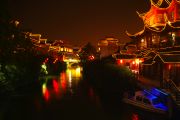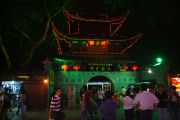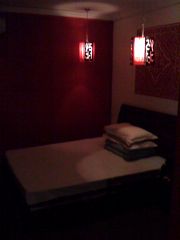Nanjing, several times China's capital, and today metropolis of 8 million people, has a great historical feel in its centre. A few areas look really how one would imagine a Chinese former capital to be. But it has entered the 21st century firmly.
|
 |
 |
 |
 |
 |
 |
 |
 |
Nanjing - centre at night
 |
 |
Although I was considering Nanjing for my initial holiday plan, I eventually dropped it from my itinerary as it did not fall into a logical route. However, since the Tibetan leg of my holiday failed miserably (following the gross incompetence and perhaps unwillingness to assist of travel agents in Shanghai and one in Chengdu), I had to change my plans, and re-routed my flights to Nanjing. Which was very easy and took only two minutes. In Nanjing, I learnt the Chinese proverb Past experience, if not forgotten, is a guide for the future (Qián shì bù wàng hòu shì zhï shï), which very adequately summarised my feelings and what I was planning to do with my experiences in China.
Anyway, Nanjing's history is amongst the most dramatic of all cities of China, if not the entire planet. During the China-Japan war in 1930s, the Chinese government not only had abandoned the citizens, it actually had locked them up in the city by sealing all but the Xiaguan Gate. The victimisation of civilians by their own government on such scale had never happened before and had not happen since. Furthermore, the Japanese army had captured Nanjing and, since it had been acceptable by the Japanese warfare standards, the soldiers had bestially raped thousands of women aged between 11 and 76.
I landed here late, after sunset. And the city by night dazzled me with the lights of the Fuzimiao district, traditional architecture, the canal and bridges, and little boats that cruised around; for ¥60 (30 min, max 5 people) by the way. ¥60 was €6 when I visited.
|
|
| Favourite spots: |
The area around the Fuzi Temple, aka ancient Confucian Temple, tightly built up in the combination of Ming and Qing dynasties styles, was my favourite part of this giant city. No traffic could be heard as the entire area, including a large portion of the immediate neighbourhood was car free. Wandering around the cafes and souvenir shops selling an ocean of colourful things ranging from miniature golden statues to colourful china teapots, cups and chars to almost glowing silk shirts to glass jewelry to wooden fans to great swords. I was tempted several times. It would be great to have a nice Chinese sword and I liked some of the teapots, but I had an entire week before me and I was almost certain I could do the shopping in Beijing. So, I just kept wandering around and annoyed the shopkeeppers.
The rest of Fuzimiao district was also great. The little bridges over the river and the building built in a traditional style made a good impression. At night it looked even better with red paper.
|
|
| What's really great: |
|
Nanjing had world's longest city wall. It was built during the Ming dynasty, when it was the capital of the Empire of China. The majority of the wall still stood when I visited. It was unusual, as it was not built in the square format like all city walls at that time (including those in Beijing and Xi'an). It zigzags (like traditional lake bridges) around the city taking advantage of the hills and canals. I thought that Xi'an's wall was enormous, and this one in Nanjing was even larger, although less complete. It had 13 gates, a few still stood when I visited. The largest, the Zhonghua Gate (¥25), had four rows of gates, where over 3,000 soldiers could station at the time of war or 1,000 permanently. The unique construction of the gate, its complexity and ingenuity made it formidable defense system. And its size made it the largest city gate in the country. It was really impressive. However, I have to expose a fake. The three towers on top of the 3 inner gates were just wooden mockups.
|
|
| Sights: |
 |
 |
 |
 |
 |
 |
 |
 |
The Jianguan Imperial Examination School
 |
 |
The Jianguan Imperial Examination School (¥20) was amongst the most photographed by the local tourists sights in Nanjing. It was founded in 1168 by Emperor Qiandao. It was the country's largest examination site with 20,644 students.
Jiming Temple, which started in 527, and then re-built reveral times, was very popular one, with people coming to pray all the time.
Other sights included the Drum Tower and the Great Bell Pavilion nearby, where a massive bell dating back to 1388 had been moved. By the Drum Tower, ancient or even prehistoric artefacts had been found, some of which were associated with the Shang and Zhou dynasties.
The red sandstone wall that once surrounded a citadel built on the site of Nanjing in the 3rd century, aka Stone City, was a complete ruin when I visited.
Perphaps the most known of all Nanjing monuments was the Xiaoling Tomb of Hongwu Emperor of the Ming Dynasty. It had its own 22km long wall!
|
|
| Accommodations: |
 |
 |
 |
 |
 |
 |
 |
 |
Room no.222 at the Fuzimiao International Hostel
 |
 |
I booked a private en-suite room (¥180) for two nights at the Fuzimiao International Hostel located in the heart of the Ming historical district. Just feet away from the pedestrianised alleys, the Confucian Temple and about 15 minute walk from the Zhonghua Gate. The room (#222) was large but dark, and had a window overlooking the canal and a bridge. It had a nice traditional Chinese feel. It was air-conditioned (very tricky to figure out the complex, in Chinese only, remote control) and had a satellite telly. The bathroom contained a shower cabin and a loo. No toiletries were provided, no toilet roll and no towels. It was relatively well scrubbed and was ventilated. The bed was large (at least queen-size) and nicely firm.
Unfortunately, this hostel did not compare well with all other hostels I stayed on this trip so far, despite its great location. It did not have a good social area, just a row of tables and couches, and there was no common room, cafe or a restaurant.
|
|
| Nightlife: |
Nanjing had a many night clubs spread across the city, none of which had a prevailing reputation. Unfortunately, majority of the clubs I heard of enjoyed rather sleazy reputation and were not cheap. Probably for the exact reason. There was no shortage of drinking and boogie halls near the old town, but I would not want to recommend any.
An alternative would be to join hundreds of local Chinese on their night feasting. Night food stands and stalls kept springing up on every corner each night and stayed open until wee hours of the morning. They were great spots to socialise with the locals and exercise sign language or practice your Chinese. It guaranteed a lot of laughter and plenty of misunderstandings. Few of those stands sold beer, so if anyone wanted a confidence booster, one would have to bring it with them.
|
|
| Hangouts: |
The Bailuzhou Park (¥20) was a pleasant spot in town surrounding a small lake. It had the Huiguang Temple (1431) with White Pagoda called The Egret Tower within its premises and the Juifeng Temple, which was frequented by worshipers. In the wooden cabins dotted around the lake, local people played instruments, sang, played games, some exercised. It was a shame that one had to pay to get in. In the hindsight, I guess the park was not entirely worth the money.
Zhanyuan Garden on the other side of the Fuzimiao district was smaller and less spectacular, if that's even the right word to describe the first one. But it was also away from the traffic, which was always a benefit in China.
By the canal, opposite the Confucian Temple was an open-air cafe, whose personnel did not speak any English, and not all from the picture-menu was available, was a great spot for people watching and being watched.
|
|
| Restaurants: |
Apparently, Nanjing was famous for duck dishes, which were made in a special way. Chengduanians were envious that I would have an opportunity to try duck in Nanjing. I made an effort therefore to go for it.
I wandered a little about Fuzimiao district looking for an authentic restaurant. The thing was that all restaurants and cafes were busy with local people only. I was the only foreign tourist in the city, it seemed, causing a bit of a sensation.
Pan Chi Jiu was a cafe I stumbled upon on one of the pedestrianised streets. I ordered the Nanjing duck and was shocked it was served cold! It was salty (it was supposed to!) and boney. I didn't like it. I also ordered a soup, which arrived in humongous quantities. It was a mistake. I paid ¥50, which by Chinese standards was expensive.
Then, for dinner I found this magnificent little curry place called Curry Haunt. It was behind the Mandarin Garden Hotel. No English was spoken and no English menu was available. Chicken curry (¥16).
|
|
| Other recommendations: |
|
The Nanjing airport was, like many others, inconveniently located some 30km outside the city. As some cities, including Beijing, Shanghai, Chengdu or Xi'an had convenient public transport connecting their airports to the core centre, Nanjing did not. In the Ming capital, the airport bus was not terminating in the most important or attractive part of the city. It was going up to the northern ends of the city. However, it made four stops, the third one being closest to the historical Fuzimiao district. The stop is completely inconspicuous, so it is better to ask someone where to head off or ask the driver. Announcements were made only in Chinese. The coaches left from stand #1 in front of the arrival hall (good signage) and tickets (¥25) had to be bought from ticket office at the stand. The taxi to the airport on the way back cost me ¥120 (¥93 meter + ¥20 road toll). I wanted to take the coach again but I couldn't establish where they stopped in town, the hostel personnel wasn't helpful.
|
|
Published on Friday September 4th, 2009
|
|
 Publish on Facebook
Publish on Facebook
|
Fri, Sep 04 2009 - 11:35 AM
 by jacko1
| A highly informative and well written report. |
Fri, Sep 04 2009 - 10:06 AM
 by porto by porto
| Great report Krys,I like the sound of that Chinese proverb as well but I think that I would give the duck a miss if I ever visited. |
| Information: |
| Login if you are a member, or sign up for a free membership to rate this report and to earn globo points! |
|
| Belgium |
|
|
|
|
|
|
 |
| Benin |
|
|
 |
| Bosnia - Herzegovina |
|
|
|
|
|
|
|
|
 |
| Botswana |
|
|
 |
| Brazil |
|
|
|
|
|
|
|
|
|
|
|
|
|

|
